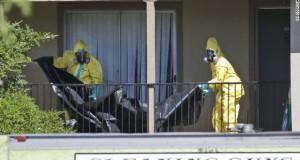Published 7 October 2014
The CDC had called for medical facilities to be on high-alert for Ebola-like symptoms, but these plans are only as effective as the practices of each hospital, and the recent Dallas case was marked by a mix-up at Texas Health Presbyterian Hospital. “We’re reiterating the message for every health worker in this country — think about travel history. If someone’s been in West Africa within twenty-one days and they’ve got a fever, immediately isolate them and get them tested for Ebola,” CDC director Thomas Frieden said.

Dallas team cleaning apartment quarantining Ebola victims contacts // Source: tinviet.net.vn
Following a series of hospital miscommunications during the recent Dallas, Texas Ebola case, officials at the Centers for Disease Control and Prevention (CDC) are reiterating their warnings that the health community needs to be further educated and prepared regarding the virus. As Government Executive reports, the CDChad called for medical facilities to be on high-alert for Ebola-like symptoms, which include high fever, severe headache, muscle pain, vomiting, diarrhea, and abdominal pain. This especially covers any patient who was traveling from Africa and had a fever within twenty-one days of exposure there.
Unfortunately, these plans are only as effective as the practices of each hospital, and the recent Dallas case was marked by a mix-up at Texas Health Presbyterian Hospital. Despite all of the red flags, the patient was not tested for the virus until his second visit. The patient had admitted himself two days earlier, but was diagnosed with a low-grade viral fever and sent home with antibiotics.
More alarmingly, a nurse at the time had asked the patient about his travel history and he had confirmed that he was visiting from Liberia.
“[That information] was not fully communicated throughout the whole team,” said Mark Lester, the executive vice president of Texas Health Resources, in regards to why the patient was then not placed in immediate isolation.
The patient first fell ill four days after landing on 19 September. Since Ebola is not contagious until symptoms appear, the two days between visits marked the time where others in Dallas would be exposed and ultimately infected.
Governor Rick Perry (R) confirmed that authorities believe some schoolchildren were in contact with the patient, though none have displayed symptoms yet.
In the follow-up, local health officials are monitoring between twelve and eighteen people who had contact with the patient, according to the Dallas Morning News. Additionally, the CDC dispatched nine representatives to Dallas that would track anyone who could have been infected.
This oversight comes after the entire staff at Texas Health Presbyterian Hospital practiced a trial-run of procedures
“We were prepared,” said Dr. Edward Goodman, an epidemiologist at the hospital, “We have had a plan in place for some time now in the event of a patient presenting with possible Ebola. We are well-prepared to deal with this crisis.”
CDC director Thomas Frieden, however, now sees the incident as an opportunity to remind health officials elsewhere to be prepared.
“We’re reiterating the message for every health worker in this country — think about travel history. If someone’s been in West Africa within twenty-one days and they’ve got a fever, immediately isolate them and get them tested for Ebola,” he said.
www.homelandsecuritynewwire.com
No comments:
Post a Comment